Most travellers visit a country for the beautiful sights you can visit. You want a change of scenery so you book a flight to some delightful, exotic location where you can tour and take photos of new places.
If you ask me, there’s more to travelling than having new sights to feast your eyes on. Travelling can also introduce you to a whole world of delicacies and dishes you’ve never heard of. It’s always a good thing to tickle your tummy and challenge yourself with new dishes that may not be considered food in other parts of the world.
Lechon
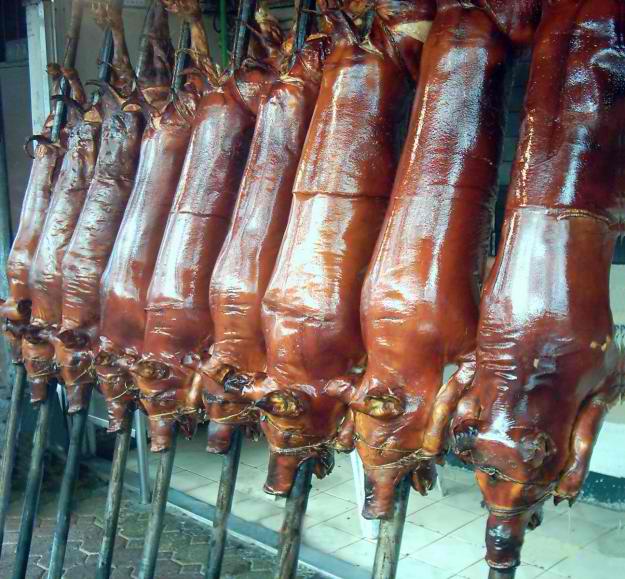
Lechon baboy is one of the highlight of Filipino
festivities, birthdays, wedding, family reunion and christmas parties. the dish was introduced by the Spaniards centuries ago while some evidence link it to Chinese immigrants. the most favorite part of Lechon is its crispy skin then dip into a liver base sauce yum. Lechon is a very delicious dish but some wasn’t cook right thats why the skin was not that yummy and crispy. and what i like the best about lechon is its left over and transformed into another dish called Lechon Paksiw. pig is not the only animal that can be roast other popular form of lechon are chicken and cow. chicken is very much affordable and can be bought almost in every corner of the country. La Loma the area between the boundary of Manila and Quezon City is the “Lechon Capital Of The Philippines” many restaurants sell lechon there and the best of them all Mila’s Lechon . Lechon of Cebu City is among the best in the Country.
Pinakbet

Pinakbet or pakbet is a popular Ilocano dish, from the northern regions of the Philippines, although it has become popular throughout the archipelago. The word is the contracted form of the Ilocano wordpinakebbet, meaning “shrunk” or “shriveled”. The original Ilocano pinakbet uses bagoong (“bugguong” in Ilokano), of fermented monamon or other fish, while further south, bagoong alamang is used. The basic vegetables used in this dish include native bitter melon, eggplant, tomato, okra, string beans, chili peppers,parda, winged beans, and others. Root crops and some beans like camote, patani, kadios are also optionally added. The young pod of marunggay is also added. It is usually spiced with ginger, onions, orgarlic. A Tagalog version usually includes calabaza. Most of these vegetables are easily accessible, and are grown in backyards and gardens of most Ilocano households. As its name suggests, it is usually cooked until almost dry and shriveled; the flavors of the vegetables are accentuated with shrimp paste. In some cases, lechon, chicharon, or other meats (most commonly pork) are added. It is considered a very healthy dish, and convenient in relation to the harsh and rugged, yet fruitful Ilocos region of the Philippines.
The vegetable dish pinakbet is more than a regional cuisine. It is an enduring symbol of the Ilocano palate and a lucid display of the Ilocanos’ history of contestations and struggles with the physical and social environment. The recipe weaves intimations of the cultural productions of the Ilokanos’ transaction to their arid and less productive land. (Caday, 2009)
Pinakbet is similar to the Provençal (French) vegetable stew ratatouille except for its sauce.
Sisig
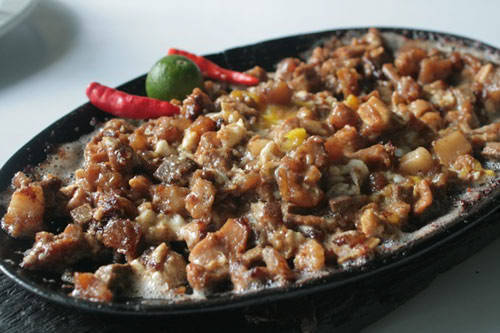
Sisig is a Kapampangan term which means “to snack on something sour”. It usually refers to fruits, often unripe or half-ripe, sometimes dipped in salt and vinegar. It also refers to a method of preparing fish and meat, especially pork, which is marinated in a sour liquid such as lemon juice or vinegar, then seasoned with salt, pepper and other spices.
Sisig also refers to Sizzling sisig, a Filipino dish made from parts of pig’s head and liver, usually seasoned with calamansi and chili peppers.
Kare Kare
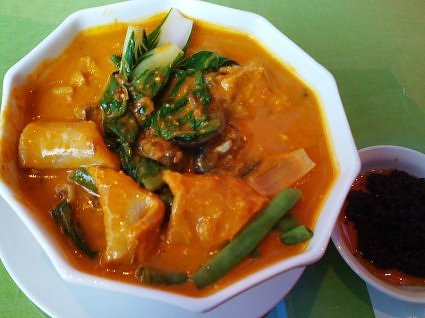
Kare-kare is a Philippine stew. It is made from peanut sauce with a variety of vegetables, stewed oxtail,beef, and occasionally offal or tripe. Meat variants may include goat meat or (rarely) chicken. It is often eaten with bagoong (shrimp paste), sometimes spiced with chili, and sprinkled with calamansi juice. Traditionally, any Filipino fiesta (particularly in Pampanga region) is not complete without kare-kare. In some Filipino-American versions of the dish, oxtail is exclusively used as the meat.
Isaw
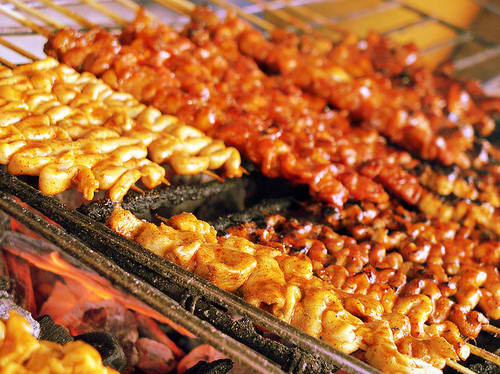
Isaw is a street food from the Philippines, made from barbecued pig or chicken intestines. The intestines are cleaned, turned inside out, and cleaned again, repeating the process several times. They are then either boiled, then grilled, or immediately grilled on sticks. They are usually dipped in kurat (Filipino term for especially made vinegar with onions and other flavour enhancers) then eaten. They are usually sold by vendors on the street corners in afternoons.
Adobo
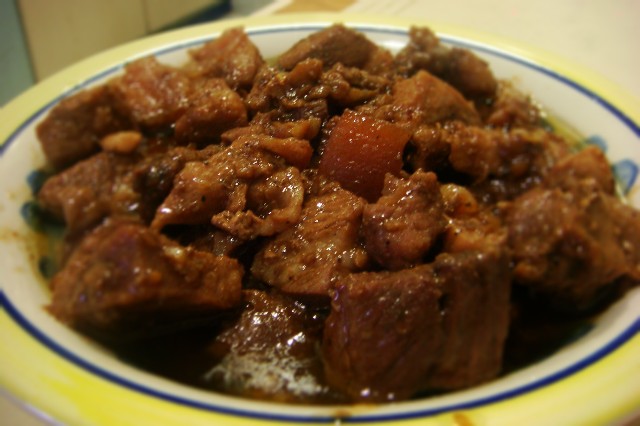
adobo refers to a common cooking process indigenous to the Philippines. It should not be confused with the Spanish and Latin American adobo, as they have different origins and refer to different dishes despite sharing the same name. When the Spanish invaded the Philippines in the late 16th century, they encountered a cooking process that involved stewing with vinegar. The Spanish referred to this method as adobo due to its superficial similarity to the Spanish adobo. Nevertheless, the Filipinoadobo is an entirely separate method of preparing food and is distinct from the Spanish marinade. There are many variations of adobo in the Philippines in which soy sauce is used like Adobong Baboy in which pork is used, Adobong Manok in which chicken is used, etc. There is also the Adobong Pusit, a squid based dish which uses the squids ink as the broth together with vinegar.
Dinuguan
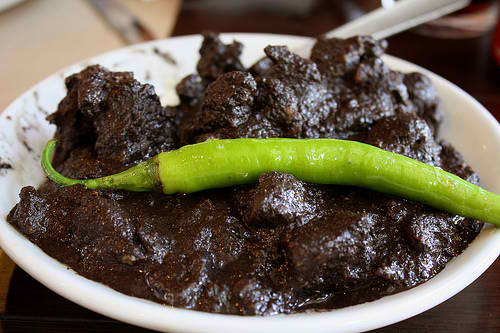
Dinuguan (in Visayan, also called dinardaraan in Ilocano, tid-tad in Pampanga, sinugaok in Batangas, rugodugo in Waray, and sampayna or champayna in Northern Mindanao. Possible translations include pork blood stew, blood pudding stew, and chocolate meat) is a Filipino savory stew of meat and/or offal (typically lungs, kidneys, intestines, ears, heart and snout) simmered in a rich, spicy dark gravy of pig blood, garlic, chili (most often siling mahaba), and vinegar. The term dinuguan comes from the Filipino word dugo meaning “blood”.
It is frequently considered an unusual or alarming dish to most people, though it is rather similar to European-style blood sausage, or British black pudding in a saucy stew form. It is perhaps closer in appearance and preparation to the Polish soup Czernina or an even more ancientSpartan dish known as melas zomos (black soup) whose primary ingredients were pork, vinegar and blood.
Dinuguan can also be served without using any offal, using only choice cuts of pork. In Batangas, this version is known as sinungaok. It can also be made from beef and chicken meat, the latter being known as dinuguang manok (‘chicken dinuguan’). Dinuguan is usually served with white rice or a Philippine rice cake called puto.
Sinigang
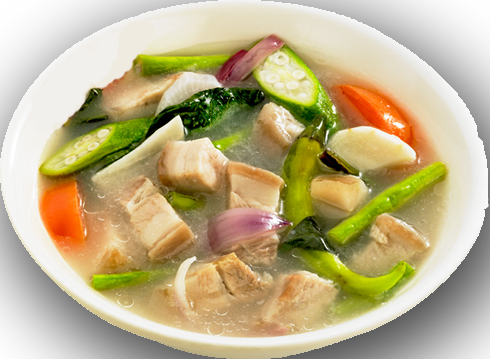
Sinigang is a Filipino soup or stew characterized by its sour flavor most often associated with tamarind(sampalok).
Sinigang is traditionally tamarind based. Other versions of the dish derive their sourness from ingredients such as guava, calamansi, bilimbi, or unripe mango among others. Powdered soup base or bouillon cubes for sinigang based on tamarind or calamondin are also used in place of natural fruits. Vinegar is not used for making sinigang sour. A similar dish made with vinegar as the primary souring ingredient would tend to be categorized as paksiw in Philippine cuisine.
Meat in sinigang (e.g., fish, pork, shrimp, or beef) is often stewed with tamarinds, tomatoes, and onions. Other vegetables commonly used in the making of sinigang include okra, taro corms (gabi), daikon (labanos), water spinach (kangkong), yardlong beans (sitaw) and eggplant (talong). Most Filipinos like to cook sinigang with green finger pepper in order to enhance the taste while adding a little spice to the dish.
A common variation of chicken sinigang is called sinampalukang manok or sinampalukan (from sampalok,Filipino for tamarind). Sinampalukan is distinguished by its use of shredded tamarind leaves. It is also made withginger, onions, and tomatoes. Sinampalukan is sometimes prepared to be a little spicier than the other sinigang dishes.
It bears some similarities to Indonesian sayur asem, Vietnamese canh chua, and Thai tom yam. Sinigang shares some characteristics—but should not be confused with—singgang, a tamarind soup dish from Terengganu, Malaysia.
Balut
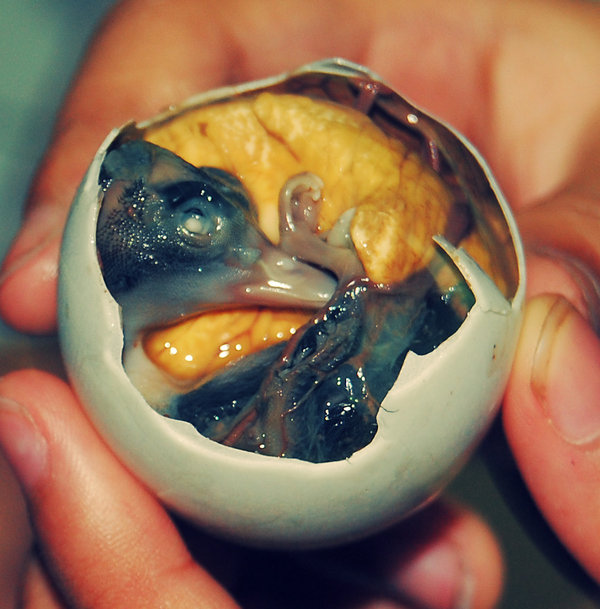
A balut is a fertilized duck embryo that’s boiled alive and eaten in the shell. Popularly believed to be an aphrodisiac and considered a high-protein, hearty snack, balut are mostly sold by street vendors in the regions where they are available. It is commonly sold as streetfood in the Philippines.